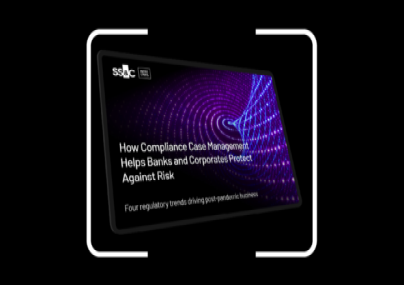 How technology can help institutions automate processes, address today’s regulatory world and avoid risk.
How technology can help institutions automate processes, address today’s regulatory world and avoid risk.
Banks and corporates today are working amid an extremely heightened regulatory landscape. The war in Ukraine and resulting sanctions on Russia and Belarus mean that companies of all types need to closely monitor and conduct thorough and frequent assessments of customers, vendors and business partners to ensure none are funding any criminal or terrorist activity. Then, if any suspicious entities, accounts or transactions are identified, these must be reported to the relevant authorities. This is an evolving and highly complex situation, posing a lot of risks that companies must be ready to address.
Add to that the pandemic, which put many business operations to the test, especially those that were manual or reliant on paper or physical media. Without secure, digitized workflow and case management systems in place, banks and corporates struggled with skyrocketing volumes of requests, inquiries and application forms as the world shifted to working and accessing services remotely.
What’s more, recent social and environmental events have brought to the fore issues that large organizations are expected to help address — such as access to financing, climate change, sustainable infrastructure, workplace diversity and transparency into business practices — issues that are also top of mind for governments and regulators.
The stakes have never been higher — reputations and revenue are on the line. Banks and corporates need to rethink and improve many existing processes: particularly compliance programs and associated controls.
Amid today's hypersensitive regulatory landscape, download SS&C Intralinks’ recent whitepaper on How Compliance Case Management Helps Banks and Corporates Protect Against Risk.
What is compliance case management?
This approach allows banks and corporates to manage thousands of inquiries that require the exchange of highly confidential information with multiple parties (customers, business partners, regulatory and/or federal authorities and more) where there are strict deadlines and severe penalties for non-compliance. Some examples: processing new account requests for business banking or brokerages; conducting know-your-customer (KYC) and anti-money laundering (AML) programs; receiving and responding to subpoenas for customer information.
As a technology solution, compliance case management sits outside an organization’s firewall and facilitates ultra-secure project workflow and document exchange. This allows the bank or corporate to rapidly respond to those numerous requests and inquiries, protect the confidential information that is exchanged in the process and mitigate any intrusion threat into their network.
Characteristics and capabilities of an ideal compliance case management solution include:
- Every inquiry is equivalent to a "case" with its own workflow, specific documents and stakeholders.
- Case creation can be automated via an intake module; an inbound request automatically creates a new case. Intake and creation can scale to the tens of thousands.
- Information is secured via encryption both in-transit and at-rest.
- Audit reports track every activity to ensure the integrity and defensibility of the process.
- Dashboards show the status of thousands of requests and responses in real-time.
- Integration with any existing systems for case management or CRM if needed.
- Significant ROI by reducing labor costs, response cycle times and shipping and related support costs of handling physical media and/or paper.
Business operations that will benefit from compliance case management exhibit four common attributes (similar to those of a strategic financial transaction such as M&A): high volume of requests and documents, sharing confidential and sensitive information, short response times and severe consequences and/or penalties for non-compliance. Case management can help better assess, monitor and report on activities related to international wire transfers, foreign exchange, crypto and digital assets. Banks and financial institutions should enhance those activities and expect more audits, assessments and examinations related to their Bank Secrecy Act (BSA), AML, OFAC and third-party oversight programs.
Case Study - How one mortgage company became more efficient – and more competitive – by implementing a broker portal.
For more than 12 years, Intralinks has been a trusted partner to Lloyds Bank, the largest commercial and retail bank in the UK. Lloyds has engaged Intralinks for numerous purposes including transactional business related to financing, secure document exchange for customer onboarding and workflow management, as well as for more complex solutions such as a custom portal to streamline communication and collaboration amongst their 4,000+ mortgage broker community. Click to learn more.
For more on the benefits of case management, please contact:

Jenkins Fung
Advisory & Corporate, Hong Kong, Macau, Taiwan
jfung@intralinks.com

Ning Chen
Advisory, Mainland China
nchen@intralinks.com
